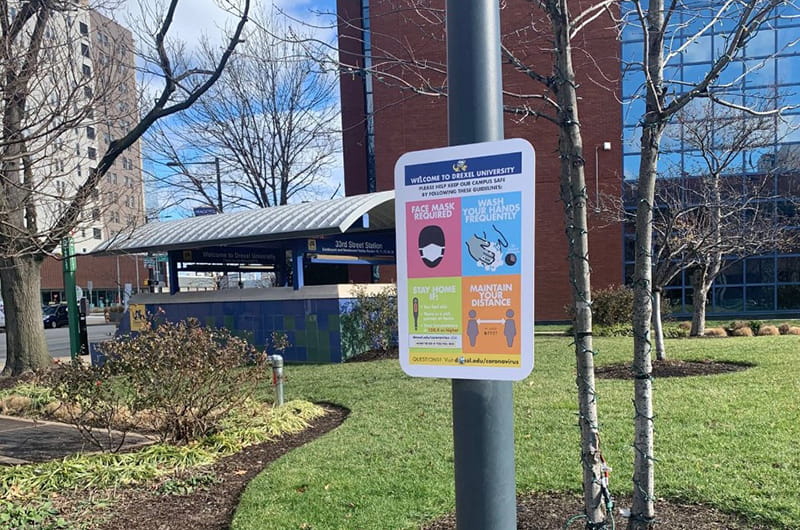How Drexel’s Campus Facilities Have Been Prepared for Winter Student Move-In

- Josephine O. Ibironke, OD, Appointed Dean of the Pennsylvania College of Optometry
- Drexel’s College of Nursing and Health Professions Receives $1 Million for Scholarships from the Bedford Falls Foundation – DAF to Address Nursing Workforce Shortage
- Laura Turner to Join Drexel University as Senior Vice President for Institutional Advancement
- When the World Changes, Drexel Changes With It

Please visit the ‘Drexel’s Response to Coronavirus’ website for the latest public health advisories.
Drexel University announced on Oct. 29 that it would welcome undergraduate students to move back on campus for winter term, of which more than 1,000 such students will do so starting Jan. 16 on a new timeline outlined on Dec. 21.
However, that was by no means also the start of the preparatory work to make sure campus met — and often exceeded — all necessary standards to keep students and other Drexel community members as safe and healthy as possible despite the COVID-19 cases that continue to rise in the city and nationally.
In fact, there was never a true “start” to this process at all, as those tasked with campus cleaning, safety and distancing measures have been on the scene since late spring, planning and working diligently to ready Drexel housing and academic spaces, as well as other amenities, for this valiant return.
“The place, I can say, has probably never been as clean and never been as well kept as it is today,” Severino continued. “That's because we've been here for several months to do everything that needs to be done.”
Jon Chase, assistant vice president of Environmental Health and Radiation Safety, said his team has supported entities across the University to establish safety measures and protocols in the face of COVID-19, from Athletics and Student Life to the Office of Research and Public Safety.
Severino’s team, which also includes the University’s custodial workers, is in charge of making sure each space is stocked with disinfecting wipes and that strict cleaning measures are upheld. His team has also replaced more than 6,000 HVAC filters across Drexel’s three campuses, and installed standalone HEPA filtration units in the 36 percent of classroom areas that were found to need supplemental air treatment to make the spaces as safe as possible.
For the seven on-campus residence halls and Greek properties where students will move in, Chase said visual cues for proper distancing have been implemented in common spaces like entrances and communal bathrooms, and plexiglass barriers have been installed at forward-facing areas like front desks, as well as between sinks that are less than six feet apart. His team also assigned max capacity to hall elevators, identified and implemented one-way traffic flow for stairways where possible, and assisted in the decision for which halls would be used for both student quarantine and isolation.
Another way Drexel’s safety measures have become collaborative is in the engagement with a third-party company to manage these quarantine and isolation spaces should students who test positive (and thus have to be in isolation) or are believed to have come in contact with a case under investigation or confirmed case (and have to be in quarantine) need to move in.
Severino said Drexel has enlisted The Arthur Jackson Company, a major local maintenance and cleaning company which already partnered with Drexel pre-pandemic, to provide cleaning services in these spaces, as well as assist students with food delivery and laundry services.
The reason for this decision, Severino said, was because of Arthur Jackson’s proven track record in health care facilities as well as the desire to ensure the safety of Drexel staff and students.
“If we continued to clean this dorm with our existing staff, we risk exposure that could impact the ability of our team members to service larger portions of the campus,” Severino said. “That could really hinder us from doing our core mission of supporting the daily operations of Drexel. So that was the main crux of why we wanted to partner with an outside entity that was more experienced in serving patient care areas. And so, Arthur Jackson has been a really good partner and has been handling our quarantine residence hall for the past three months. … They’ve done a really good job, and so far, Student Life and students have been happy with the service.”
All residence hall common areas and bathrooms will be cleaned at least once a day, he said, and large areas across campus including large classroom spaces, lecture halls, auditoriums and residence hallways and stairwells will be treated with sanitizing “fogger” machines that were actually purchased by the University well before the pandemic, for use during flu season.
“Then, when COVID hit, this was seen as a really good means to the clean areas quickly and disinfect them and inactivate the virus,” Severino said. “So we had that as part of our cleaning plan from the very beginning when [other institutions] were just trying to catch up and purchase these foggers, which to this day are still on monthslong backlog.”
Chase added that seeing the machines in action may look like “spraying a giant can of Lysol,” though Severino also confirmed that the sanitizer used is much safer than Lysol. These machines will also be used in regular residencies to disinfect rooms of individuals who test positive for the virus, Chase confirmed.
That’s because all of this work — which never really “began,” but has remained an on-going, ever-evolving process — is worth every hour, dollar and effort to bring Drexel’s vibrant campus and community back to the fore.
“Our whole goal is to have our students be able to return, and that's been our goal from the beginning,” Severino said. “We would do whatever takes to support our students being able to return and to rejuvenate this campus, breathe some more life into it. It just isn't the same without them and our faculty and staff.”
In This Article
Drexel News is produced by
University Marketing and Communications.
